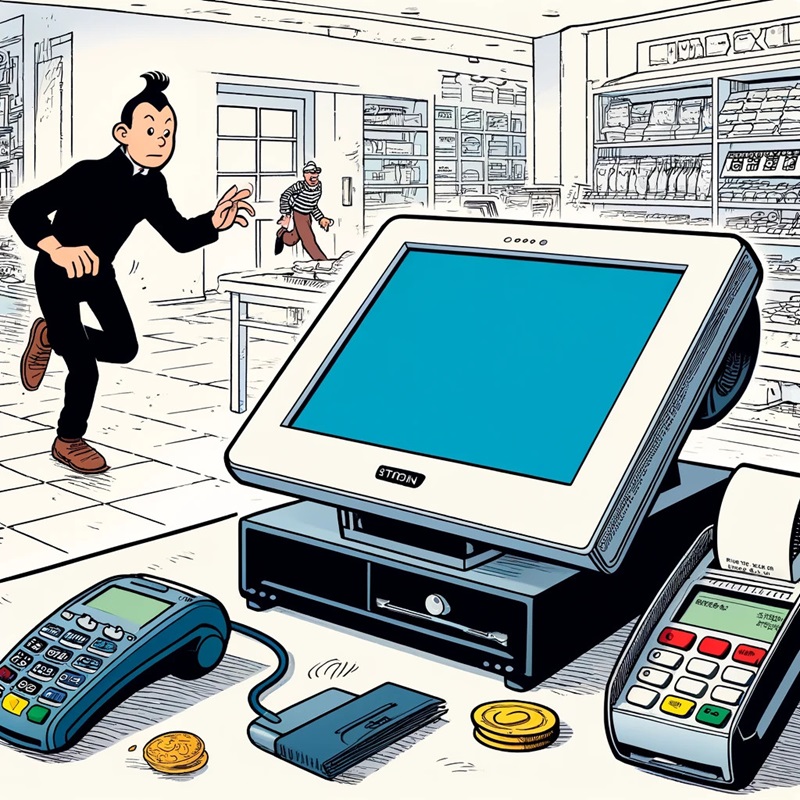
Security Threats in POS Systems
POS systems, being at the forefront of transaction processing, are prime targets for various security threats. Understanding these threats is the first step towards mitigating them effectively. Here are some of the most common security threats faced by POS systems:
Malware: Malicious software designed to infiltrate POS systems can capture sensitive data such as credit card information. Types of malware affecting POS systems include keyloggers, memory scrapers, and ransomware. These malicious programs often enter systems through phishing attacks, insecure networks, or compromised third-party software.
Skimming: This involves the physical tampering of POS hardware to capture card information during a transaction. Skimming devices can be attached to card readers or even embedded within them. Criminals then retrieve this information to create counterfeit cards or engage in fraudulent transactions.
Phishing: Cybercriminals use phishing attacks to trick employees into providing sensitive information or downloading malware. These attacks typically involve fraudulent emails that appear legitimate, urging recipients to click on malicious links or attachments.
Man-in-the-Middle (MitM) Attacks: In this type of attack, an attacker intercepts and potentially alters the communication between the POS system and the payment processor. This can lead to the capture of sensitive data or the alteration of transaction details.
Insider Threats: Employees or contractors with access to POS systems can intentionally or unintentionally compromise security. Insider threats can result from malicious intent, negligence, or lack of proper security training.
Outdated Software: Running outdated POS software or operating systems can leave systems vulnerable to known exploits. Cybercriminals often target these vulnerabilities to gain unauthorized access to systems.
Case Studies of High-Profile Breaches
Several high-profile breaches have highlighted the vulnerabilities of POS systems and the severe consequences of security lapses. Here are a few notable examples:
Target (2013): In one of the largest retail breaches, attackers infiltrated Target’s network through a third-party vendor and installed malware on POS systems. The breach compromised the credit and debit card information of approximately 40 million customers, resulting in significant financial losses and damage to the company’s reputation.
Home Depot (2014): Similarly, Home Depot suffered a massive breach where attackers used custom-built malware to target the company’s POS systems. The breach exposed the payment information of around 56 million customers. Home Depot had to invest heavily in security upgrades and faced numerous lawsuits and regulatory fines.
Wendy’s (2016): A POS malware attack on Wendy’s compromised the payment information of customers at over 1,000 franchise locations. The attack highlighted the challenges of securing POS systems across a decentralized franchise network and underscored the importance of robust security practices and regular system audits.
Emerging Threats in the POS Landscape
As technology evolves, so do the tactics of cybercriminals. Emerging threats in the POS landscape include:
Advanced Persistent Threats (APTs): These are long-term targeted attacks where attackers establish a foothold within the network and remain undetected for extended periods. APTs are sophisticated and often involve multiple stages of infiltration and data exfiltration.
IoT Vulnerabilities: The increasing integration of Internet of Things (IoT) devices with POS systems introduces new attack vectors. Insecure IoT devices can be exploited to gain access to the broader network, including POS systems.
Artificial Intelligence (AI)-Powered Attacks: Cybercriminals are beginning to use AI to enhance the effectiveness of their attacks. AI can automate and optimize attack strategies, making them more adaptive and harder to detect.
Supply Chain Attacks: Attacks targeting the supply chain can compromise POS systems indirectly. By infiltrating software providers or third-party vendors, attackers can introduce malware into POS systems through legitimate updates or services.
Mitigation Strategies
To combat these threats, businesses must implement comprehensive security measures, including:
Regular Software Updates and Patching: Ensure all POS software and hardware are updated regularly to protect against known vulnerabilities.
Employee Training and Awareness: Conduct regular training sessions to educate employees about security best practices and how to recognize potential threats like phishing attempts.
Strong Authentication and Access Controls: Implement multi-factor authentication (MFA) and role-based access controls to limit access to sensitive systems and data.
Encryption and Tokenization: Use encryption to protect data in transit and at rest. Tokenization replaces sensitive data with tokens, reducing the risk of exposure in case of a breach.
Network Segmentation: Separate the POS network from other business networks to limit the potential spread of malware and unauthorized access.
Continuous Monitoring and Incident Response: Employ real-time monitoring tools to detect and respond to security incidents promptly. Have an incident response plan in place to minimize damage in the event of a breach.
